Introduction
Nowadays, many recognized brands and well-established companies are experiencing difficulties in attracting new and retaining longstanding customers. Research supports that a troubling trend is the failure of these businesses, to recognize the need to craft smart technology-driven marketing and sales strategies that successfully target the different generational consumer groups with the highest purchasing power and monetary resources. This dilemma begs the question – why are so many experienced and skilled managers allowing the apparent destruction of their business by poor decisions or indecision?
The lack of a corporate generational strategy is generally traceable to a management team primarily comprised of Baby Boomers and Gen X men and woman, devoid of awareness and appreciation of the Millennials (Gen Y) and Generation Z personality characteristics and needs. It is also a reality that protected ‘sacred cows’ limit adoption of the essential strategies to modernize the business with generational sensitivities, given the entrenched stakeholders’ unshakable clout and unfriendliness to change! Concurrently, these conditions stretch outward to the marketplace, where the critical absence of a marketing and sales strategy, rooted in generational considerations, is resulting in a real or potential revenue downturn.
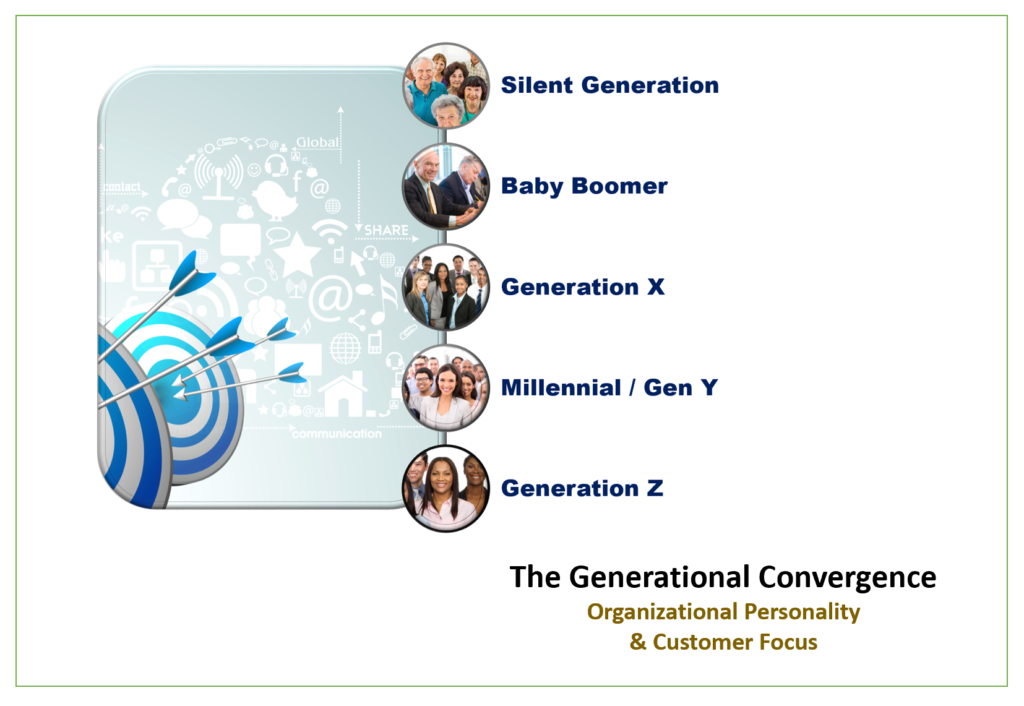
Multi-generational workplaces and technology are affecting the significant dimensions of work: the work itself, who completes the work, and the work location. The central tenets of the new work concept are independence, freedom, and participation in the community. The skills needed for success are less about employee Intelligence Quotient (IQ) and more about employees who possess high Emotional intelligence (EI).
Emotional intelligence (EI) is the ability for employees to recognize their emotions and those of others, discern between different feelings and identify them appropriately, use emotional information to guide thinking and behavior, and manage and adjust emotions to adapt to environments or achieve one’s goals.
The structure, content, and process of work have changed with successful infrastructures recognized in today’s economy with the characteristics outlined below.
- Agile organization with reduced hierarchical structure.
- Champion team-based and collaborative.
- Continual learning and knowledge-building experiences.
- Dependent on social (soft) skills.
- Devolved decision-making.
- Discover value from the customer standpoint.
- Empowered customer-facing employees.
- Focused on quality outcomes for all activities.
- Leverage and exploit technological competence.
To create value from workplace changes, organizations should take a broader perspective with a rethink and development of multi-generational targeted strategies and approaches to support the necessary change to their organization personality and customer focus.
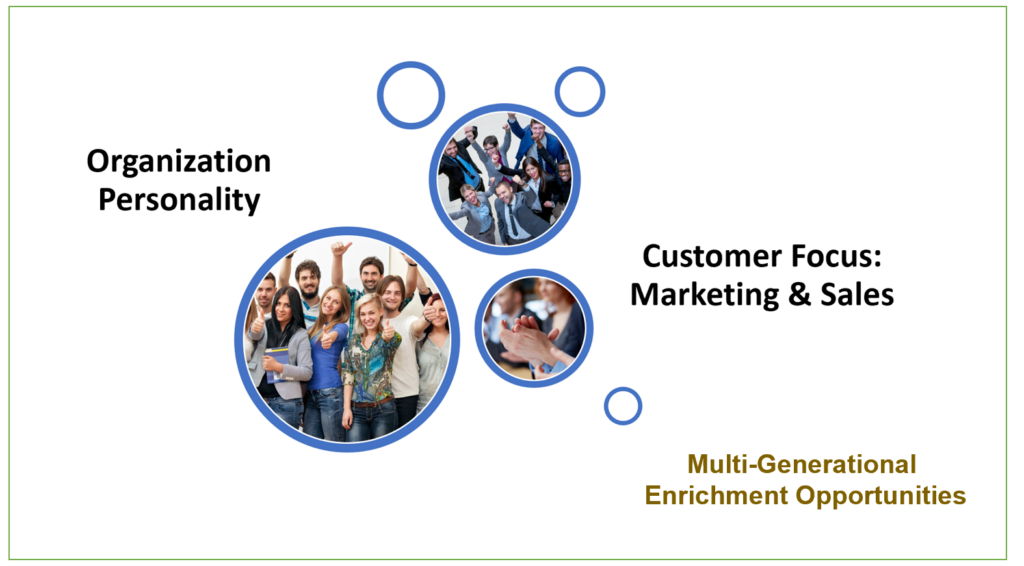
“For older workers, their younger colleagues offer an opportunity to pass on their skills and knowledge (79%) and for the creativity they bring to the work environment (73%). For younger workers, older colleagues are valued for their skill as teachers (77%), for providing an opportunity to consider a different perspective (76%), and for making the workplace more productive (69%).”
AARP
The 2020 Active Work Generations
Generations are groups of people born during a given during span of years. They have experienced similar life conditions, share a standard set of formative events and trends, mindsets and behaviors, and distinguish themselves from other generational periods. Some common influences among the groups are easy to identify, such as current events, technology, economic times, education, and fads.
There are five distinct generations currently active as market participants as business executives and consumers: Silent Generation, Baby Boomer, Gen X, and Millennials (Gen Y), and Generation Z. Each category characteristically exhibits unique traits, behaviors, and preferences that greatly influence their business and product purchase decisions. Every age readily adjusts and enhances the previous generation’s approaches to fit with the technology of the day, processing capabilities, and recognized consumer purchasing behaviors and needs.
This vibrant blend of generations in the workforce can be attributed principally to labor shortages experienced in many industries and the rising average age of retirement. In recent years, some businesses, especially those in the healthcare and service industries, have amended their employment strategy to include retaining nurses and technicians past retirement age and hiring retirees back into the workforce. For financial reasons, many Boomers realize they need to wait longer to retire, some into their seventies.
While some of the most critical insights emerge from an examination of how generations are blending and merging, it is essential to clarify how – in general terms – these groups diverge. The table below presents a selection of the differences among the generational groups.
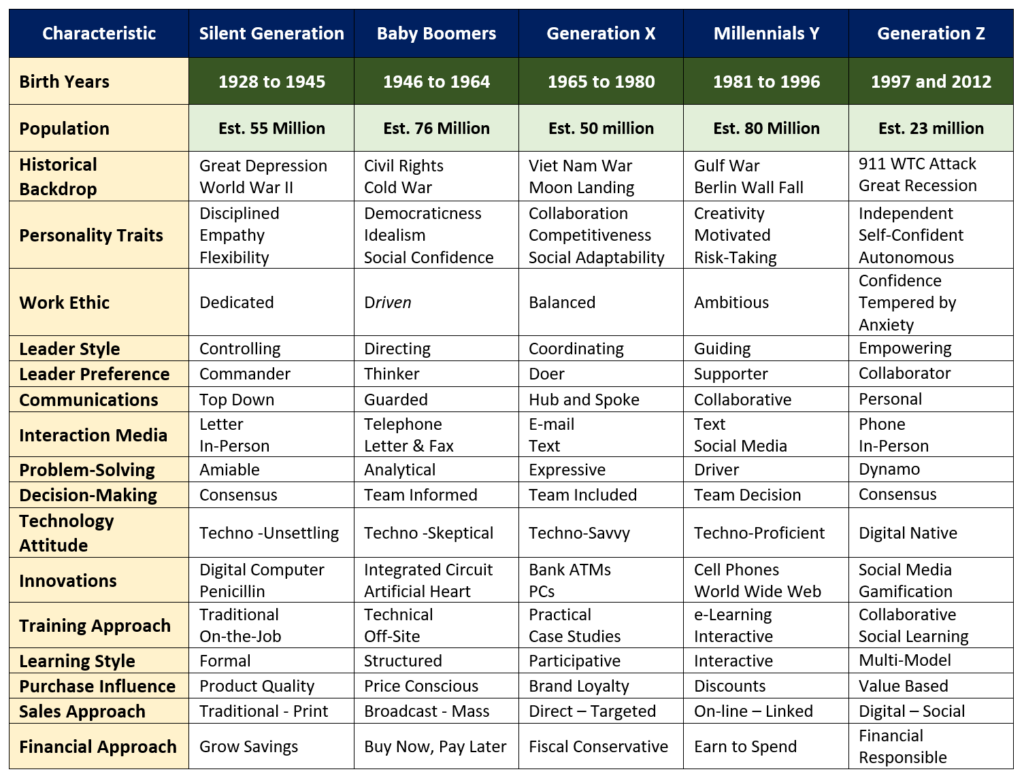
Generational group members come of age during different social, economic, and cultural periods, and mature with strikingly distinct personality traits and behaviors. These variances present each generation with unique work values and ethics and preferences for managing and being managed. The multi-generational workforce has the potential for both positive rewards and senseless and high-risk clashing among employees with different mindsets and filters.
For the first time, five generations are working together at the same time with their differences influencing all facets of organizational culture from employee behavior to morale and performance. As a result, generations are colliding and causing cultural damage among the employee population. This situation has made it more and more necessary for organizations to recognize, differentiate, and appreciate each generation’s goals and approach to the workplace.
Generational differences, in the United States, can be even more pronounced than in other parts of the world. Americans from an early age value individuality, self-expression, and the pursuit of happiness, leading to quicker personal changes on social and political matters than in other societies. This condition results in a distinct stratification of values and ideals, in which people with relatively marginal age differences can hold profoundly divergent views and positions.
Today, the trend, within the business sectors globally, is for ever-increasing numbers of Millennial and Generation Z employees to rise through the ranks and take their seats at the leadership table alongside the Baby Boomers and Generation Xers.
“The workplace has become a psychological battlefield and the millennials have the upper hand, because they are tech savvy, with every gadget imaginable almost becoming an extension of their bodies. They multitask, talk, walk, listen and type, and text. And their priorities are simple: they come first.”
Morley Safer
Multi-Generational: Organization Personality
Predictably, different generations do not regularly find common ground on a range of topics and events! People come of age during different periods with various social, economic, and cultural contexts, and as a result, end up with noticeably different behaviors and traits. Employees bring their values and lifestyle choices and attitudes to the workplace, which influences their expectations that result in different ways of communicating and connecting with managers and colleagues.
When considering generational differences, it is essential to remember that while trends and research suggest each generation has unique characteristics, not everyone within a given age is the same!
Inevitable different generations tend to clash in social, work, and family situations. Tensions, within the multi-generational workforce, habitually occur because of the diverse group’s unique values and behaviors that lead to disputes on strategy, policy, and procedures. These situations arouse strong passions and beliefs with managers and employees that tend to upset the workplace harmony and cohesion.
When faced with the conflict, many employees often likely escalate and assert their position, rather than seeking to understand and find common ground for quick and mentally-healthy resolution. For businesses, constant employee disagreements and strife result in an erosion of a positive culture and the glue that creates and sustains team harmony and fellowship. With an understanding of the strengths, constraints, and values of each generation, companies can enact policies and procedures to lessen the potential of generational conflicts.
The first step to effectively manage and develop the modern multi-generational workforce is a formal assessment of the generational group and individual people’s values and motivations concerning their work style and behaviors and the technologies used to complete work assignments. The positive outcome of this approach is gaining an appreciation of each worker’s particular character, likes, dislikes, and work ethic.
It is essential that the assessment considers potential human resource problems and risks inherent to each specific generational group integration and shifts and plans to mitigate. The outcome of a generational evaluation can provide the company’s leadership’s team with the appropriate insights and purpose to support plans to:
- Create unfettered bridges between the various generation groups of employees.
- Rework organizational attitudes for work styles, financial and non -financial rewards and recognition, and motivators that match generational expectations and life styles.
- Leverage and blend the strengths of each generation to support workplace requirements and corporate goals.
- Develop a policy to promote the values of each generational group.
- Support the communication preferences for each generation.
“Sixty-two percent of Generation Z anticipate challenges working with Baby Boomers and Generation X; only 5 percent anticipate challenges working with Millennials.”
Inc.
The value of a multi-generational assessment supports the design or improvement of a positive corporate character where employees of all ages are valued and able to contribute without reservations to the company’s success. This resultant positive workplace can create a dynamic and socially-acceptable environment able to sustain and prosper with the integration and disruption with the employment of many different generations, currently and into the future.
By appreciating and showing empathy with the preferences, passions, and motivating factors of a multi-generation setting, the leadership team should earn new employee respect and loyalty, leading to a more engaged, collaborating, and empowered workforce.
Multi-Generational: Marketing & Sales
Multi-generational marketing targets the needs and values of individuals within various generational groups. From the Silent Generation to Generation Z, each generation has its own defining culture that has characterized their coming-of-age and shopping habits. For example, each generation has atypical beliefs, values, generational chronicle, lifestyles, values, demographics, and social experiences that influence their purchasing behaviors and preferences. In this context, businesses need to proactively discover and comprehend the buying patterns and decision-making process of these diverse consumer groups.
The two critical guidelines of multi-generational marketing cover:
- Products require customization that supports generational life stage needs and their purchase decisions.
- Product promotional activities targeting generational groups reflect the values that drive buyer preferences and behavior.
In today’s competitive economy, successful businesses smartly respond to the changing trends and directions of generational requirements by validating buyer behavior and quickly adjusting their product composition and marketing and sales approaches and plans accordingly. Seasoned marketing executives typically blend the best traditional and modern-day marketing and sales practices as opposed to a total makeover. For example, many time-honored traditions may effectively support Baby Boomers and Gen X populations, while others may be digitally-enriched or discarded for the Millennials and Gen Z community.
It is vital to realize that generation is only one dynamic influencing purchasing behavior. For example, differences within a generation can be more significant than variations within particular groups. As well, generations typically do not have razor-sharp edges in that some people near a generational age break often do not belong clearly to either generation.
When a company factors in the different generational elements, the value-add is the crafting of more responsive marketing and sales strategies that can more easily win the trust and confidence of the targeted generational groups.
The Technology Influence
The transformation of corporate marketing and sales should be easier to achieve within the high-velocity digital era with innovative digital-based technologies, increased information access, more market transparency, and user-friendly data analytics. With older and newer generations increasingly extensive use of mobile and web apps and devices to support their purchases, digital tools are remaking the way consumers across all ages interact with purchased products and services. Using the right smart apps and social media engagement techniques can help businesses build profitable customer lifetime relationships.
As each generation embraces and uses technology differently, it’s essential to keep their preferences and behaviors at the forefront of the development of the corporate multi-generational marketing approach. Focusing on what makes each generation delighted with their required technical features, delivering the appropriate functional product, and promoting via relevant messaging through high-value channels will lead to sales activities success.
“Baby Boomers continue to trail both Gen Xers and Millennials on most measures of technology adoption, but adoption rates for this group have been growing rapidly in recent years. For example, Boomers are now far more likely to own a smartphone than they were in 2011 (68% now vs. 25% then).”
Pew Research
Generational Targeting and Promotion
Stagnant marketing, or promoting only to a current customer base, is setting companies up for failure at a future date. While the current customer population provides the primary source of revenue and profit, marketing executives must plan for when this group is no longer viable as the target demographic.
Strategic generational marketing provides an opportunity to drill deep into the targeted specific market segments’ needs and likings. The traditional one-size-fits-all marketing campaigns are proving not to be productive currently, as each age group demands a more individualized and customized focus that aligns with their particular generational-influenced preferences. Companies should avoid taking a formulaic view of prospects and employ a more nuanced marketing approach.
Development of a ‘Big Tent’ Multi-Generational Program is a practical approach in which all groups are held together with strategies that join the collective characteristics and leverages the diversity of the differences across all groups.
The key generational-focused considerations for a business to research, study, and construct plans encompass the items highlighted in the table below.
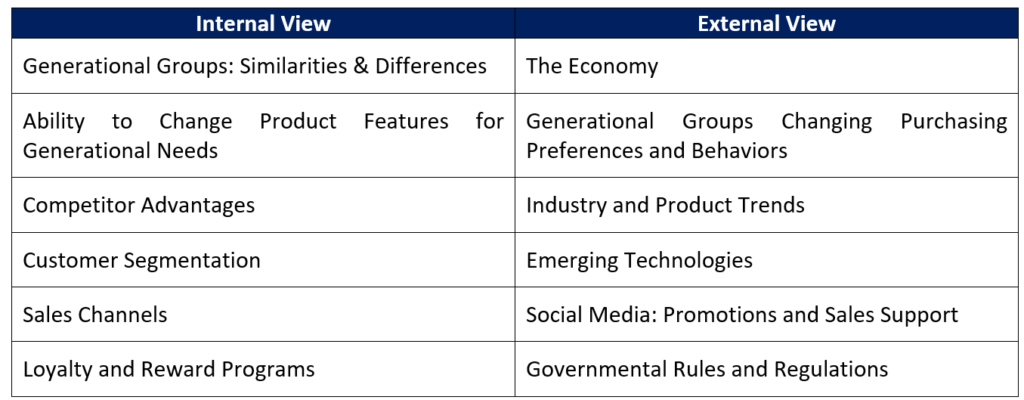
The most effective technique to quickly gather the information to target and attract generational customers is a formal research reach-out to high-value demographic groups. Conducting focus groups and surveys can provide valuable supporting information and insights into the buying behaviors, motivations, and financial projections of different generational groups.
Sales Methodology & Generational Focus
In the current market environment, sales managers face a broad diversity of prospect purchase behaviors based on differences across generations. This variety comes challenges and opportunities in managing a multi-generational sales team.
A sales methodology consists of shepherding tenets that define how a company engages and sells its products and services to customers. Contrasting a sales process that focuses on identifying the phases and tasks to purchase, the methodology provides a customized framework for how the sales associate will approach, communicate, and interact with a prospect to win the deal.
A company’s sales methodology should align the selling experience with their products, customer needs, generational aspirations, and market environment. Any divergence will feel unnatural to both the sales associate and the customer. Nowadays, the creation of an effective sales methodology is with a generational core based on the use of an integrated approach of various time-tested methods, including:
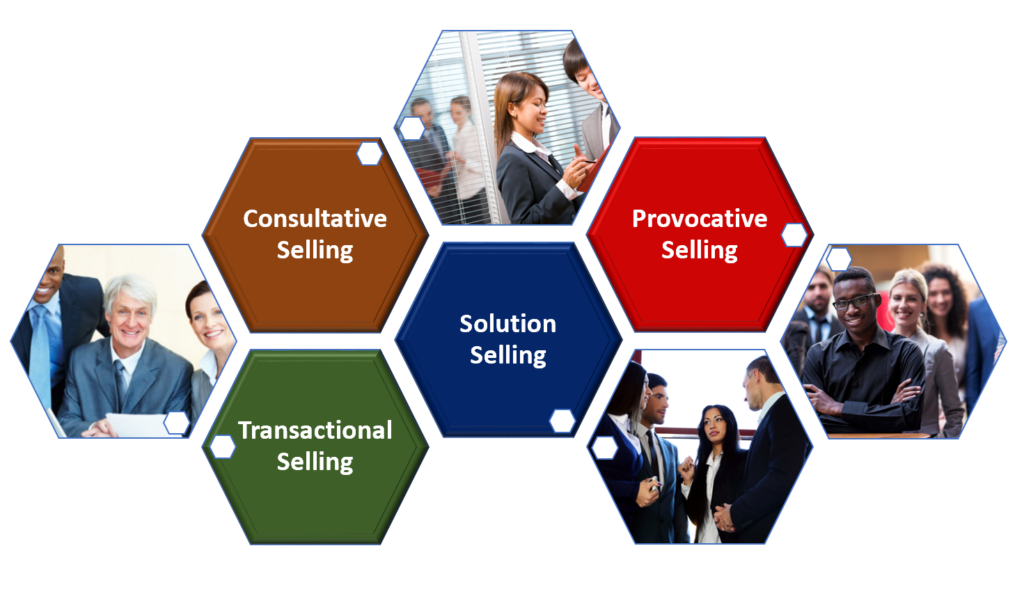
A critical success factor (CSF) is the recruitment and selection of sales associates capable of productively working and thriving in a multi-generational environment that demonstrate active business and competence knowledge and experience, strong software skills, and positive behaviors.
The Good and Bad News
The good news is that today’s salespeople are easily trainable to work more effectively with the array of generational buyers by developing improved soft skills that directly influence marketing and sales traits and behaviors.
The bad news is the unwillingness for many companies to adapt and modernize their marketing strategies and approaches and invest in necessary employee training. Also, hiring Millennials and Gen Z employees and training them in outmoded techniques and tools will likely result in a failed marketing and sales plan and unmet financials.
Benefits of Establishing a Multi-Generational Workforce
There are a wide array of significant benefits to be gained by the company and the employees when a multi-generational team successfully works well together. A positive, inclusive corporate work culture can lead to business success by enhancing recruitment, retention, and profitability.
A multi-generational environment supports a workforce with the characteristics below.
- Attract and retain exceptionally talented people of all ages.
- Stronger decision-making because it is broad-based with multiple perspectives and diversity.
- More innovative and creative employee population.
- Gain and maintain a competitive advantage because its members reflect a multi-generation market.
- Meet the product and services needs of a diverse public. relate
- Support a more collaborative work environment.
“Having a multigenerational workforce can, and should, be a distinct advantage for companies today. The wide range of ideas and knowledge from a broad group of people can actually serve the company well, and help employees excel in their work.”
Forbes
The Way Forward
At Knowledge Compass we bring together nearly four decades of thought leadership in business and technology strategy, the latest tools and best practices, and a seasoned consultant team with the competencies and talent to help our clients improve productivity and profitability of all enterprise business and support activities.
Knowledge Compass explores and develops valuable new insights from business, technology, and science by embracing the powerful technology of ideas and brainstorming. Our consultants engage customers in challenging discussion and experimentation to expand the boundaries of business science and practice and translate creative ideas into practical solutions from within and beyond business.
Working with Knowledge Compass means a collaborative approach to understanding your current business model, strategies, and key business requirements and goals.
Knowledge Compass provides consulting services with the use of an array of Frameworks, Analyses Tools, and Interactions from their Best Practices Consultant Toolbox.


